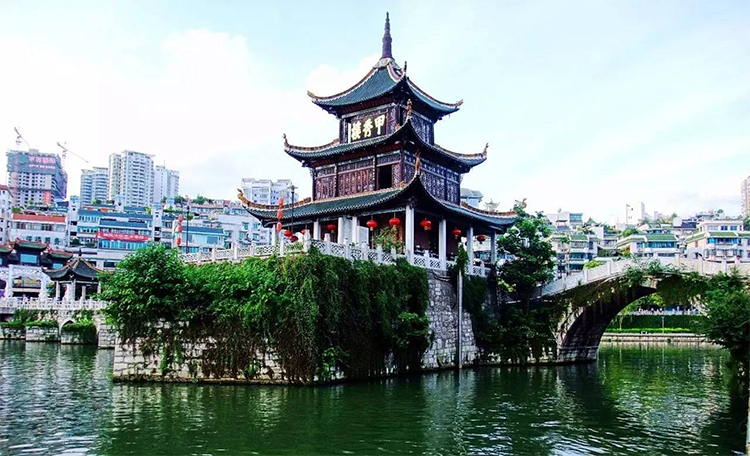Qingyan Ancient Town: 600-Year Fortress and Ethnic Culture Travel Guide
Intro
Push open Qingyan Ancient Town’s heavy gate and you walk into a living Ming–Qing epic. Once a 600‑year‑old garrison and military stronghold, today it’s a time‑capsule of stone streets, green‑tiled wooden houses and layered ethnic history. Han, Miao and Bouyei cultures meet here; alleys hide the scholar Zha o Yijiong’s residence and the battered arrow marks on the city towers still whisper of past battles. As one of Guizhou’s four major ancient towns, Qingyan is both a cultural landmark and an intact example of a military and commercial hub.
1. Core Features: Military Fortress and Living Multiethnic Exhibit
One sentence soul: The best‑preserved Ming–Qing military town in Guizhou — a ‘‘living fossil’’ where stone pavements and multiethnic customs intersect.
– Heritage value: A national 5A scenic area and a listed historic town, home to 37 documented cultural relics that concentrate Ming–Qing architecture, military design and commercial life from central Guizhou.
– Unique sights: 1.2 km of intact Ming–Qing stone streets, green limestone city walls shaped by the terrain (rare in China), and vernacular houses blending Han siheyuan courtyards with minority stilt‑house features.
– Cultural code: Tangible evidence of the Ming military garrison system, the hometown of Qing dynasty top scholar Zhao Yijiong (Zhao Zhuangyuan), and a place where Miao silverwork, Bouyei weaving and Han carved window frames coexist.
2. Historical Depth: From Garrison Fortress to Commercial Town
Military origins
In 1378, under Emperor Hongwu of the Ming, a fortified garrison was built here to secure the southwest. The city walls are stacked from the local green limestone, designed for both defense and flood control. The surviving D ingguang Gate (Dingguangmen) still shows the original wengcheng (barbican) and arrow‑slit fortifications.
Commercial and cultural rise
In the Qing, the town prospered as a tea‑horse trade node along the Yunnan–Guizhou route. Shops thrived; the residence of Zhao Yijiong (the first ranked imperial scholar in Guizhou) features a green‑brick spirit screen and the plaque ‘‘Qin‑He Jia‑Sheng’’ reflecting Confucian influence mixing with frontier local elites.
Tip: Notice the shallow central drainage channel running along the middle of the stone streets — a clever Ming–Qing design that keeps alleys dry in heavy rain.

3. Sights and Seasons: Every Season Has a Scene, Mist and Rain Are Most Poetic
– Best time to visit: Spring and autumn (March–May, September–November) for mild weather and to avoid summer storms and winter damp cold.
– Iconic moments:
– Dingguangmen in morning mist: Early fog can make the walls appear floating — a photographer’s dream.
– Rain‑slick back alleys: The polished bluestone reflects light and the towering stone walls create a narrow ‘‘one‑line‑sky’’ effect.
– Dusk at Wenchang Pavilion: Climb the pavilion to overlook the town’s green‑tiled roofs as sunset gilds century‑old architecture.
4. Deep Experiences: Beyond Sightseeing
– Cultural immersion:
– Try on Miao dress for photos in the old street; join a batik or silverwork workshop at the North Gate Plaza.
– Visit during the lunar New Year Qingyan Temple Fair to see local opera, reed‑pipe dances and sample seasonal snacks like Qingming cakes and rose sugar.
– Walking: A one‑hour walk along the city wall offers panoramic views of the ancient town and distant karst ridges.
– Food discoveries: Local specialties include herb‑braised pork hock, rice‑cake porridge and spicy chicken triangles — try the longtime shop ‘‘Jin Bixuan’’ for authentic flavors.

5. Practical Guide: Transport, Tickets and Routes
How to get there
– From central Guiyang: 40 minutes by car (navigate to “Qingyan Ancient Town North Gate”), or take bus 203 or Huaxi Bus 18 (about 1 hour).
– From Guiyang North Railway Station: Taxi about 50 minutes, roughly 80 RMB.
Tickets and opening times
– Tickets: Peak season (Mar–Oct) 60 RMB; off‑season 40 RMB (includes small sites such as Wenchang Pavilion). Night visits are free for entries after 17:30.
– Opening hours: 8:30–17:30; many alleys are open 24 hours.
Suggested routes
– Half‑day highlights: Dingguangmen → back alleys → Zhao Zhuangyuan’s residence → Ciyun Temple → Ming–Qing Street food.
– Full‑day deep tour: Add the wall walk, Wanshou Palace (Taoist temple), and a Miao embroidery workshop.
Suitability: The stone paths have some slopes but are generally walkable for seniors and children. There are no cable cars; expect walking.
6. Beat the Crowds: Local Secrets
– Crowd tips: Weekends and public holidays are busiest (especially 10:00–15:00). Arrive before 08:00 or visit on weekdays for quieter exploration.
– Hidden gem: Longquan Temple outside the South Gate is seldom crowded; its ancient well has sweet water locals often use to collect drinking water.
Conclusion: Why Make a Special Trip to Qingyan?
Qingyan avoids over‑commercialization and preserves everyday life within stone streets. Whether you want to touch the weathered city wall, sip herbal tea in a century house, or photograph misty ramparts at dawn, Qingyan offers an immediate time‑slip into Ming–Qing frontier life. It’s Guizhou’s architectural textbook of the era and a three‑dimensional chronicle of frontier garrisoning and ethnic coexistence.
Set out now — let Qingyan’s morning bells, braised‑meat aromas and scholarly echoes be your first chapter in exploring Southwest China.


